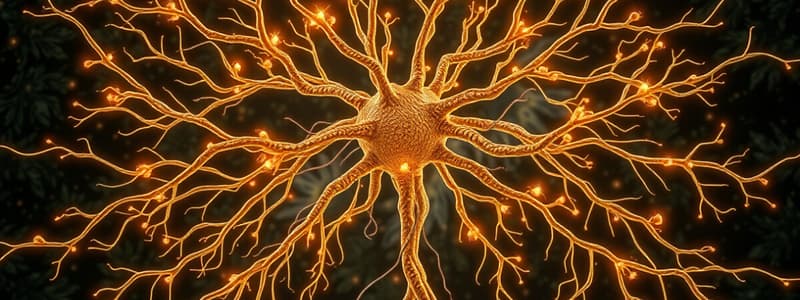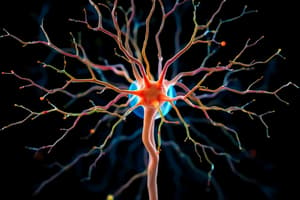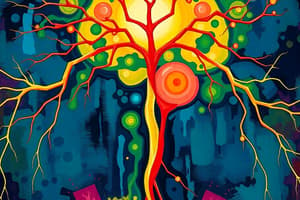Podcast
Questions and Answers
Which cell is primarily responsible for transmitting signals in the nervous system?
Which cell is primarily responsible for transmitting signals in the nervous system?
- Neuron (correct)
- Myofiber
- Osteoblast
- Chondrocyte
What regulates involuntary activities within the nervous system?
What regulates involuntary activities within the nervous system?
- Somatic nervous system
- Voluntary nervous system
- Autonomic nervous system (correct)
- Cerebral cortex
Which type of neuron transmits signals away from the central nervous system?
Which type of neuron transmits signals away from the central nervous system?
- Sensory neuron
- Motor neuron (correct)
- Efferent neuron
- Interneuron
What is the term for a persistent fear of something?
What is the term for a persistent fear of something?
Which structure is formed where two neurons connect?
Which structure is formed where two neurons connect?
Which type of matter is made up of myelinated axons?
Which type of matter is made up of myelinated axons?
What is a disorder characterized by recurrent seizures?
What is a disorder characterized by recurrent seizures?
What structures bring signals to the neuron cell body?
What structures bring signals to the neuron cell body?
Which division of the nervous system controls voluntary movements?
Which division of the nervous system controls voluntary movements?
What are bundles of neuron fibers in the peripheral nervous system called?
What are bundles of neuron fibers in the peripheral nervous system called?
What is the primary role of the cerebellum within the brain?
What is the primary role of the cerebellum within the brain?
Which statement accurately describes afferent nerves?
Which statement accurately describes afferent nerves?
Which term refers to the automatic, rapid response to a stimulus?
Which term refers to the automatic, rapid response to a stimulus?
What does the autonomic nervous system primarily regulate?
What does the autonomic nervous system primarily regulate?
What is the term for the chemical that transmits signals across a synapse?
What is the term for the chemical that transmits signals across a synapse?
What condition is characterized by the absence of the brain?
What condition is characterized by the absence of the brain?
Which of the following describes the function of cerebrospinal fluid?
Which of the following describes the function of cerebrospinal fluid?
Which type of nerve carries only motor signals?
Which type of nerve carries only motor signals?
What is the impact of Alzheimer disease on brain function?
What is the impact of Alzheimer disease on brain function?
Which diagnostic tool is used for recording brain electric activity?
Which diagnostic tool is used for recording brain electric activity?
What is the basic functional unit of the nervous system?
What is the basic functional unit of the nervous system?
Which structure is responsible for controlling involuntary activities in the body?
Which structure is responsible for controlling involuntary activities in the body?
What is the junction between two neurons called?
What is the junction between two neurons called?
What part of the brain is responsible for coordination and balance?
What part of the brain is responsible for coordination and balance?
Which term describes carrying impulses toward the CNS?
Which term describes carrying impulses toward the CNS?
What type of neuron carries impulses away from the CNS?
What type of neuron carries impulses away from the CNS?
What fatty substance insulates axons in the nervous system?
What fatty substance insulates axons in the nervous system?
What is the most likely diagnosis for a patient with sudden weakness on one side and slurred speech?
What is the most likely diagnosis for a patient with sudden weakness on one side and slurred speech?
Which part of the nervous system is primarily affected by a stroke?
Which part of the nervous system is primarily affected by a stroke?
Which reflex response is characterized by an involuntary action to a stimulus?
Which reflex response is characterized by an involuntary action to a stimulus?
Flashcards are hidden until you start studying
Study Notes
Nervous System
- The nervous system is divided into the central nervous system (CNS) and the peripheral nervous system (PNS).
- The CNS includes the brain and spinal cord, while the PNS includes all other nerves in the body.
- The nervous system controls body functions by transmitting signals between different parts of the body.
- The PNS is further divided into the somatic nervous system, which controls voluntary movements, and the autonomic nervous system, which regulates involuntary activities.
The Neuron
- Neurons are the basic building blocks of the nervous system, with a cell body, dendrites, and an axon.
- Dendrites receive signals and transmit them to the cell body, while axons send signals away from the cell body.
- Myelin is a fatty substance that covers some axons, aiding in faster signal transmission.
- Myelinated axons form white matter, while unmyelinated axons form gray matter.
- Sensory neurons transmit signals to the CNS, while motor neurons transmit signals away from the CNS.
- A synapse is the junction between two neurons, where signals are passed using neurotransmitters.
Nerves
- Nerves are bundles of neuron fibers in the PNS.
- A ganglion is a collection of neuron cell bodies along a nerve pathway.
- Some nerves are purely sensory or motor, while most are mixed nerves, carrying both types of signals.
Brain and Spinal Cord
- The brain is responsible for higher-level functions such as memory, reasoning, sensory relay, hormone control, vital functions, coordination, and balance.
- The spinal cord, extending from the brainstem to the lower back, connects to 31 pairs of nerves for sensory and motor control.
Autonomic Nervous System
- Controls involuntary activities, including muscle, cardiac muscle, and gland regulation.
Nervous System Terminology
- Afferent: Carrying signals toward a given point, like sensory neurons towards CNS.
- Efferent: Carrying signals away from a given point, like motor neurons away from CNS.
- Autonomic Nervous System: Regulates involuntary functions, controlling muscles, cardiac muscle, and glands.
- Central Nervous System: Composed of the brain and spinal cord.
- Cerebrospinal Fluid: Watery fluid circulating around brain and spinal cord, providing protection.
- Synapse: Junction between two neurons, or between a motor neuron and a muscle or gland.
- Reflex: An automatic and rapid response to a stimulus.
- Neurotransmitter: Chemical that transmits signals across a synapse, examples include norepinephrine and acetylcholine.
Related Terms
- Amyloid: A starch-like substance accumulating in the brain during Alzheimer's and other diseases.
- Coma: A state of deep unconsciousness from which a person cannot be roused.
- Concussion: Injury resulting from a violent blow or shock, often causing temporary loss of consciousness.
- Convulsion: Series of violent, involuntary muscle contractions, tonic convulsions involve prolonged muscle contraction.
- Dementia: Gradual and irreversible loss of intellectual function.
- Encephalitis: Inflammation of the brain.
- Epilepsy: A chronic condition characterized by periodic sudden bursts of electrical activity in the brain, resulting in seizures.
- Parkinsonism: Disorder stemming from the brain's basal ganglia, marked by slow movements, tremor, rigidity, and mask-like facial expressions.
- Paralysis: Temporary or permanent loss of function, movement, or reflexes.
- Alzheimer Disease: A form of dementia caused by atrophy of the cerebral cortex.
- Tremor: Shaking or involuntary movement.
- Anxiety: Feeling of fear, worry, uneasiness, or dread.
- Schizophrenia: Severe mental disorder characterized by psychosis, delusions, hallucinations, and withdrawn or bizarre behavior.
- Depression: Mental state characterized by profound sadness, emptiness, hopelessness, and lack of interest or pleasure in activities.
Diagnostic and Treatment Terms
- Electroencephalography (EEG): Amplification, recording, and interpretation of brain's electrical activity.
- Cerebral Angiography: Radiographic study of brain's blood vessels after injection of a contrast medium.
Test Your Knowledge
- 1. What is the basic functional unit of the nervous system? (Neuron)
- 2. Which structure is responsible for controlling involuntary activities in the body? (Autonomic Nervous System)
- 3. What is the junction between two neurons called? (Synapse)
- 4. What part of the brain is responsible for coordination and balance? (Cerebellum
Matching Terms to Definitions
- 1. Synapse: (b) Junction between two neurons
- 2. Afferent: (e) Carrying impulses towards the CNS
- 3. Myelin: (d) Fatty substance that insulates axons
- 4. Reflex: (c) Involuntary response to a stimulus
- 5. Efferent: (a) Carrying impulses away from the CNS
Case Study
- Most likely diagnosis: (b) Stroke
- Primarily affected part of the nervous system: (c) Central Nervous System
Studying That Suits You
Use AI to generate personalized quizzes and flashcards to suit your learning preferences.




